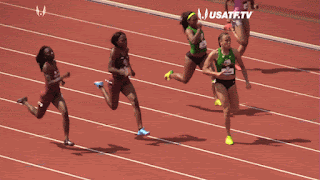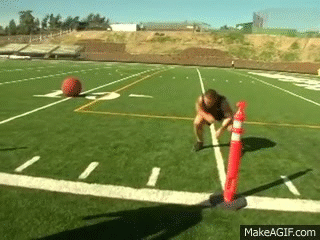Motor Fitness Test for Youth
Motor fitness tests:-
Motor Fitness refers to the capability of an athlete to take part effectively in his/her sport. It is also known as ability of an individual to perform physical activities.
There are 8 types of motor fitness tests:-
1. 50 m Standing Start/ 50 m Dash :
Procedure - An area of 50 m is marked on a track. Two parallel lines are drawn 50 m apart considering one as starting line. The subject takes the starting position behind the starting line. At the command of 'Go' one start running. Two subjects can run at same time if there are two stopwatches.
Equipment Required - Measuring tape or marked track, 2 stopwatches.
Purpose - The purpose is to determine or measure speed.
2. 600 m Run/Walk :
Procedure - The subject takes the position of standing right behind the starting line. At the signal of ''GO" the subject starts running 600-yard distance. During the course of running he may walk. Multiple students can run at same time, time is recorded in minutes and seconds.
Equipment Required - 600 metre track and stop watches.
Purpose - To measure endurance.
3. Sit and reach :
The sit-and-reach test was first founded by Wells & Dillon in 1952.
Procedure - First of all shoes and socks should be removed. Then sit down on floor with legs stretched out straight ahead. The soles of the feet should be kept flat against the box. Both the knees should be locked and pressed flat to the floor. An assistant can help the performer to hold the knees down. Palms should be facing downwards, hand should be on top of each other. The individual performing this task should try to extend his hand as much as possible. Tips of both hands should be on same point, he should not jerk. Hold the full reach for 2 seconds. In case of sliding ruler📏 the zero mark should be at tips.
Equipment required - Sit and reach box or a box and ruler.
Purpose - Main Objective is to measure hip flexibility including lower back.
Scoring - The score is recorded to nearest centimetre based on distance reached by an individual.
4. Partial Curl Up :
Procedure - In the very beginning of this task whole procedure is explained to the subject. Subject has to lie on spine on a cushioned surface. The knees should be flexed and feet should be 12 inches from the buttocks. Both the feet should be slightly apart. The arms are extended and arrested on thighs. The head should be in neutral position, this is the starting position. Then the subject commerce up with a slow controlled moment until is complete kalp is completed every 3 seconds. These are continued until the subject fields unable to maintain the rhythm. It should be in continuation.
Equipment Required - A flat cushioned surface and a pen, paper to note down.
Purpose - The main objective is to measure the strength of abdominal muscle and are also significant for maintaining good posture.
Scoring - Record the total number of partial curl ups. Curl will not be counted if shoulder not raised up by 2 inches.
5. Push Ups (boys) :
Procedure - Before this test their should be complete warm up. Now ask the subject to take push up position, hands and toes to touch the mat for floor. Hand should be shoulder width apart. The upper body and legs should be in a straight line. Elbow should be fully extended keep in the back any straight. Now the subject has to lower his upper body so that elbow may comes at 90', then return back to starting position with arms extended. This test is continued till the exhaustion of subject.
Equipment Required - A plain surface or a mat and a pen, paper to record basic information.
Purpose - To test and measure upper body strength.
Scoring - Total number of push ups perfectly done by an individual is the final score.
6. Modified Push Ups (girls) :
Procedure - the subject is asked to take starting position for modified push ups. In a modified push up position hand and knees should touch the mat for floor. Both the hand should be shoulder width apart and elbows fully extended. Now the body from the knees to the hips and to the shoulder should be in a straight line while keeping this position the subject lower and upper body so that the elbow may bend to 90°. Now the subject returns back to the starting position the same action should be repeated till the exhaustion of the subject.
Equipment Required - A flat surface or mat and a pen, paper to record basic information.
Purpose - To measure or calculate upper body strength and endurance.
Scoring - The total number of push ups done by an individual is a total score.
7. Standing Broad Jump :
Procedure - A take off line is marked on ground, player stands some inches behind this line. The subject swing the arm and bends the need to take a jump in the long jump pit. Three trials are given to the subject the distance is measured from the take off line to the heel or other part of body that touches the ground nearest to the take off line.
Purpose - To measure the explosive power of legs.
Equipment Required - A sandy long jump pit and a measuring steel tape.
Scoring - All jumps are measured and the best one is recorded in inches or feets.
8. 4×10 m Shuttle Run :
Procedure - Mark two parallel line 3 metres in length and 10 metre apart using marking tape or cones, considering one line as starting line. Two wooden blocks are placed in the age of other line. On the signal 'go' the subject runs to the wooden block, let's one block and return to the starting line and placing the block behind the line. Then the subject return to the second block lift it and then run across the starting line on the way back. Two trials are given.
Equipment Required - Two wooden block or cones, a stopwatch, and a flat surface.
Purpose - To measure agility of an individual.
Scoring - Record the best time to complete the test in seconds to the nearest decimal place.
Thankyou for visiting.











Comments